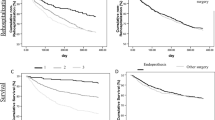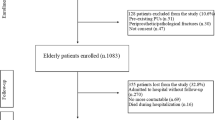Abstract
Summary
Hip fractures are common in elderly people. Despite great progress in surgical care, the outcome of patients with hip fracture remains disappointing. This study determined four prognostic factors (lower ASA score, higher pre-fracture EQ-5D index, higher MMSE score, and female gender) to predict 1-year survival in patients with hip fracture.
Introduction
This study determined the prognostic factors for 1-year survival in patients with hip fracture. Based on these predictors, a scoring system was developed for use upon patients’ admission to the hospital.
Methods
Hip fracture patients, aged ≥60 years, were prospectively enrolled. Upon admission, patients’ sociodemographic data, type of fracture, American Society of Anesthesiologists (ASA) score, health-related quality of life scores (EQ-5D index) and Mini-Mental State Examination (MMSE) scores were recorded, among other parameters.
Correlational analysis was performed on all potential variables to identify relevant predictor variables of 1-year survival. Univariate regression analysis was performed on all selected variables, followed by a multivariate analysis for variables that were significant in the univariate analysis. The final score was developed by converting the β-coefficients of each variable from the multivariate analysis into a scoring system.
Results
For 391 hip fracture patients, complete data were available at the time of the 1-year follow-up. In multivariate regression analysis, independent predictors of 1-year survival were lower ASA score, higher pre-fracture EQ-5D index, higher MMSE score, and female gender.
The different variables were weighted according to their β-coefficient to build the prognostic score, which ranged from 0 to 10 points. The ROC curve for 1-year mortality after hip fracture showed an area under the curve of 0.74 (R 2 = 0.272; 95 % CI 0.68–0.79; p < 0.001).
Conclusions
With only four instruments, the new score represents a useful tool for estimating 1-year survival in elderly patients with hip fractures. At present, the score is limited due to a lack of validation. A validation study is currently underway to prove its reliability.


Similar content being viewed by others
References
Icks A, Arend W, Becker C, Rapp K, Jungbluth P, Haastert B (2013) Incidence of hip fractures in Germany, 1995–2010. Arch Osteoporos 8:140
Roth T, Kammerlander C, Gosch M, Luger TJ, Blauth M (2010) Outcome in geriatric fracture patients and how it can be improved. Osteoporos Int 21:S615–S619
Hu F, Jiang C, Shen J, Tang P, Wang Y (2012) Preoperative predictors for mortality following hip fracture surgery: a systematic review and meta-analysis. Injury 43:676–685
Becker C, Gebhard F, Fleischer S, Hack A, Kinzl L, Nikolaus T, Muche R (2003) Prediction of mortality, mobility and admission to long-term care after hip fractures. Unfallchirurg 106:32–38
Kanis JA, Odén A, McCloskey EV, Johansson H, Wahl DA, Cooper C, Life IWGoEaQo (2012) A systematic review of hip fracture incidence and probability of fracture worldwide. Osteoporos Int 23:2239–2256
Borgström F, Lekander I, Ivergård M et al (2013) The International Costs and Utilities Related to Osteoporotic Fractures Study (ICUROS)—quality of life during the first 4 months after fracture. Osteoporos Int 24:811–823
Konnopka A, Jerusel N, König HH (2009) The health and economic consequences of osteopenia- and osteoporosis-attributable hip fractures in Germany: estimation for 2002 and projection until 2050. Osteoporos Int 20:1117–1129
Sobolev B, Sheehan KJ, Kuramoto L, Guy P (2015) Excess mortality associated with second hip fracture. Osteoporos Int 26:1903–1910
Dawe EJ, Lindisfarne E, Singh T, McFadyen I, Stott P (2013) Sernbo score predicts survival after intracapsular hip fracture in the elderly. Ann R Coll Surg Engl 95:29–33
Maxwell MJ, Moran CG, Moppett IK (2008) Development and validation of a preoperative scoring system to predict 30 day mortality in patients undergoing hip fracture surgery. Br J Anaesth 101:511–517
Foss NB, Kristensen MT, Kehlet H (2006) Prediction of postoperative morbidity, mortality and rehabilitation in hip fracture patients: the cumulated ambulation score. Clin Rehabil 20:701–708
Mohamed K, Copeland GP, Boot DA, Casserley HC, Shackleford IM, Sherry PG, Stewart GJ (2002) An assessment of the POSSUM system in orthopaedic surgery. J Bone Joint Surg Br 84:735–739
Krishnan M, Beck S, Havelock W, Eeles E, Hubbard RE, Johansen A (2014) Predicting outcome after hip fracture: using a frailty index to integrate comprehensive geriatric assessment results. Age Ageing 43:122–126
Wright DM, Blanckley S, Stewart GJ, Copeland GP (2008) The use of orthopaedic POSSUM as an audit tool for fractured neck of femur. Injury 39:430–435
Kirkland LL, Kashiwagi DT, Burton MC, Cha S, Varkey P (2011) The Charlson Comorbidity Index Score as a predictor of 30-day mortality after hip fracture surgery. Am J Med Qual 26:461–467
Baker SP, O’Neill B, Haddon W, Long WB (1974) The injury severity score: a method for describing patients with multiple injuries and evaluating emergency care. J Trauma 14:187–196
Anestesiologists ASo. ASA physical status classification system. www.asahq.org/clinical/physicalstatus.html [Accessed June 10 Accessed June 10 2014
EQ-5-D (2009) EQ-5-D; A standardised instrument for use as a measure of health outcome; User Giude; 2009. Accessed Accessed 2 May 2012
Charlson ME, Pompei P, Ales KL, MacKenzie CR (1987) A new method of classifying prognostic comorbidity in longitudinal studies: development and validation. J Chronic Dis 40:373–383
Lübke N, Meinck M, Von Renteln-Kruse W (2004) The Barthel Index in geriatrics. A context analysis for the Hamburg Classification Manual. Z Gerontol Geriatr 37:316–326
Folstein MF, Folstein SE, McHugh PR (1975) “Mini-mental state”. A practical method for grading the cognitive state of patients for the clinician. J Psychiatr Res 12:189–198
Sheikh J, Yesavage J (1986) Geriatric Depression Scale (GDS): recent evidence and development of a shorter version. Clin Gerontol 5:165–172
Lawton MP, Brody EM (1969) Assessment of older people: self-maintaining and instrumental activities of daily living. Gerontologist 9:179–186
Harris WH (1969) Traumatic arthritis of the hip after dislocation and acetabular fractures: treatment by mold arthroplasty. An end-result study using a new method of result evaluation. J Bone Joint Surg Am 51:737–755
Rösler A, Krause T, Niehuus C, von Renteln-Kruse W (2009) Dementia as a cofactor for geriatric rehabilitation-outcome in patients with osteosynthesis of the proximal femur: a retrospective, matched-pair analysis of 250 patients. Arch Gerontol Geriatr 49:e36–e39
Podsiadlo D, Richardson S (1991) The timed “Up & Go”: a test of basic functional mobility for frail elderly persons. J Am Geriatr Soc 39:142–148
Sinoff G, Ore L (1997) The Barthel activities of daily living index: self-reporting versus actual performance in the old-old (> or = 75 years). J Am Geriatr Soc 45:832–836
Greiner W, Claes C, Busschbach JJ, von der Schulenburg JM (2005) Validating the EQ-5D with time trade off for the German population. Eur J Health Econ 6:124–130
(AWMF). AWMF (2009) S3-guideline dementia, long version. AWMF. Accessed 11 May 2014
Buecking B, Struewer J, Waldermann A, Horstmann K, Schubert N, Balzer-Geldsetzer M, Dodel R, Bohl K, Ruchholtz S, Bliemel C (2014) What determines health-related quality of life in hip fracture patients at the end of acute care?—a prospective observational study. Osteoporos Int 25:475–484
Sebestyén A, Mester S, Vokó Z et al (2014) Wintertime surgery increases the risk of conversion to hip arthroplasty after internal fixation of femoral neck fracture. Osteoporos Int 26(3):1109–1117
Ray RI, Aitken SA, McQueen MM, Court-Brown CM, Ralston SH (2014) Predictors of poor clinical outcome following hip fracture in middle aged-patients. Injury 46(4):709–712
Guerado E, Cano JR, Cruz E, Bertrand ML, Hirschfeld M, Benitez-Parejo N (2014) Should hip fractures be operated upon only by specialist hip unit surgeons in order to lower rates of surgical site infection? Int Orthop 39(1):105–110
van Zeeland ML, Genovesi IP, Mulder JW, Strating PR, Glas AS, Engel AF (2011) POSSUM predicts hospital mortality and long-term survival in patients with hip fractures. J Trauma 70:E67–E72
Wiles MD, Moran CG, Sahota O, Moppett IK (2011) Nottingham Hip Fracture Score as a predictor of one year mortality in patients undergoing surgical repair of fractured neck of femur. Br J Anaesth 106:501–504
Söderqvist A, Ekström W, Ponzer S, Pettersson H, Cederholm T, Dalén N, Hedström M, Tidermark J, Group SHF (2009) Prediction of mortality in elderly patients with hip fractures: a two-year prospective study of 1,944 patients. Gerontology 55:496–504
Michel JP, Klopfenstein C, Hoffmeyer P, Stern R, Grab B (2002) Hip fracture surgery: is the pre-operative American Society of Anesthesiologists (ASA) score a predictor of functional outcome? Aging Clin Exp Res 14:389–394
Donati A, Ruzzi M, Adrario E, Pelaia P, Coluzzi F, Gabbanelli V, Pietropaoli P (2004) A new and feasible model for predicting operative risk. Br J Anaesth 93:393–399
Tarazona-Santabalbina FJ, Belenguer-Varea A, Rovira Daudi E, Salcedo Mahiques E, Cuesta Peredó D, Doménech-Pascual JR, Gac Espínola H, Avellana Zaragoza JA (2014) Severity of cognitive impairment as a prognostic factor for mortality and functional recovery of geriatric patients with hip fracture. Geriatr Gerontol Int 15(3):289–295
Schaller F, Sidelnikov E, Theiler R et al (2012) Mild to moderate cognitive impairment is a major risk factor for mortality and nursing home admission in the first year after hip fracture. Bone 51:347–352
Ekström W, Miedel R, Ponzer S, Hedström M, Samnegård E, Tidermark J (2009) Quality of life after a stable trochanteric fracture—a prospective cohort study on 148 patients. J Orthop Trauma 23:39–44
Ekström W, Németh G, Samnegård E, Dalen N, Tidermark J (2009) Quality of life after a subtrochanteric fracture: a prospective cohort study on 87 elderly patients. Injury 40:371–376
Abrahamsen B, van Staa T, Ariely R, Olson M, Cooper C (2009) Excess mortality following hip fracture: a systematic epidemiological review. Osteoporos Int 20:1633–1650
Acknowledgments
The authors wish to acknowledge Lutz Waschnick, Natalie Schubert, Anna Waldermann, Kristin Horstmann, and Anne Hemesath, who contributed to the acquisition of data. Universiätsklinikum Giessen und Marburg (UKGM) funding was received for analysis of the data and conception of a follow-up study.
Author information
Authors and Affiliations
Corresponding author
Ethics declarations
Institutional review board approval from the local ethics committee was obtained for this study. All patients or their legal representatives provided written informed consent for study participation.
Conflicts of interest
None.
Rights and permissions
About this article
Cite this article
Bliemel, C., Sielski, R., Doering, B. et al. Pre-fracture quality of life predicts 1-year survival in elderly patients with hip fracture—development of a new scoring system. Osteoporos Int 27, 1979–1987 (2016). https://doi.org/10.1007/s00198-015-3472-8
Received:
Accepted:
Published:
Issue Date:
DOI: https://doi.org/10.1007/s00198-015-3472-8




